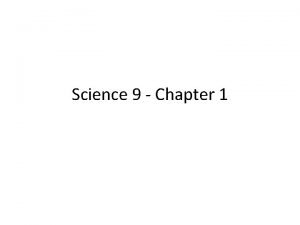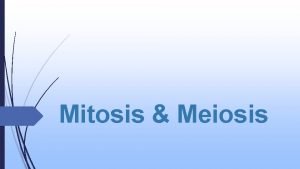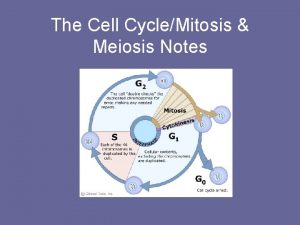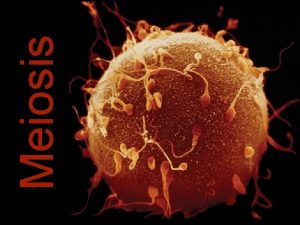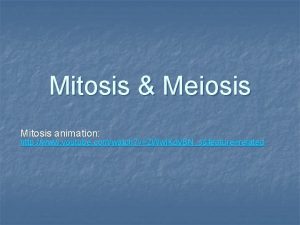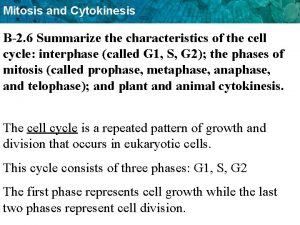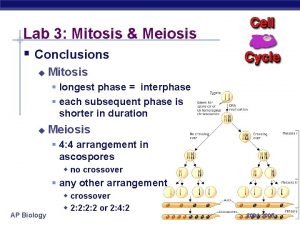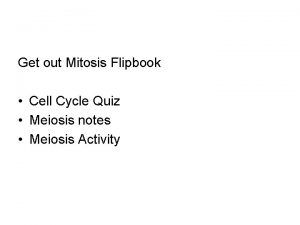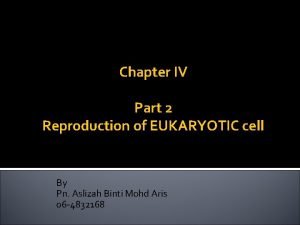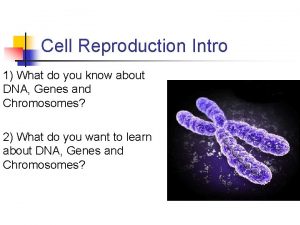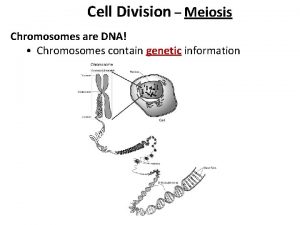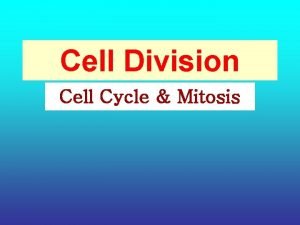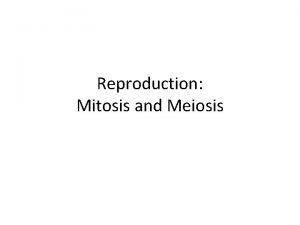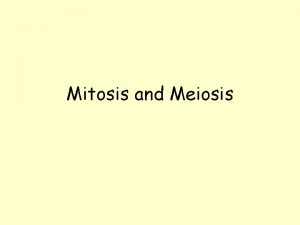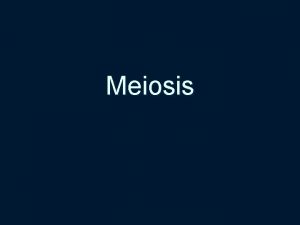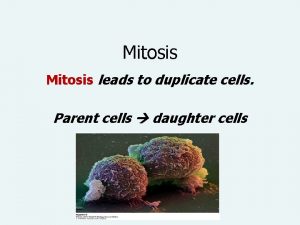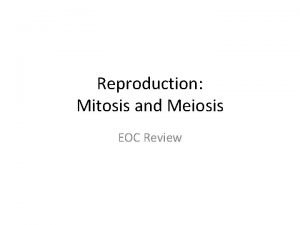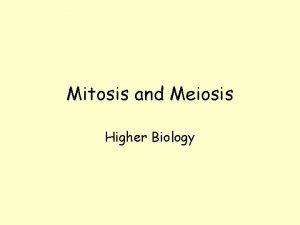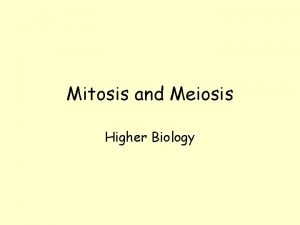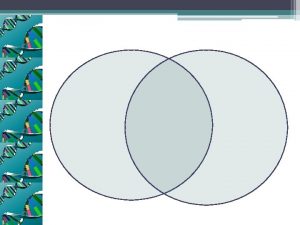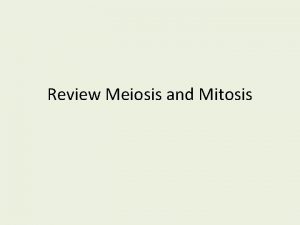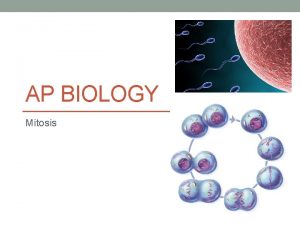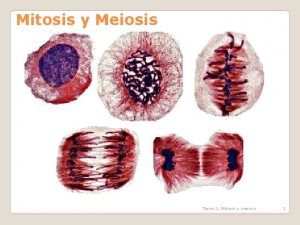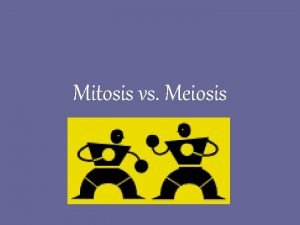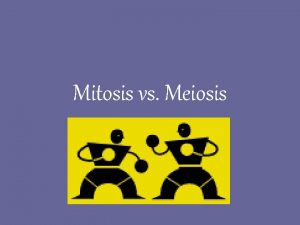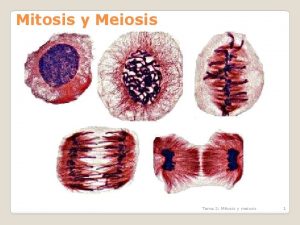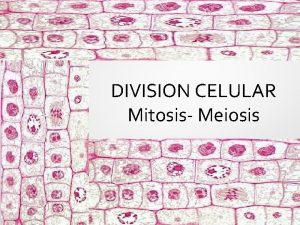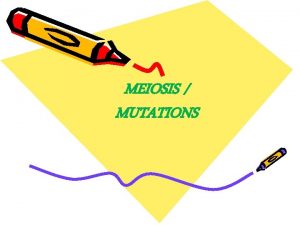Meiosis In Mitosis Parent and daughter cells have




















- Slides: 20

Meiosis

In Mitosis • Parent and daughter cells have the same number of chromosomes • These chromosomes occur in two sets (♀, ♂) and the two sets are called homologous chromosomes • The total number of chromosomes is referred to as the diploid number (2 n)

Meiosis • Is similar to mitosis in that it is just a single replication of nuclear material BUT: • This replication is followed by TWO cell divisions, creating 4 gametes with haploid number of chromosomes (n) • Ex. each cell only has ONE copy of each chromosome

Meiosis: • Is the division process that forms sexual gametes (sex cells sperm and eggs in humans). These gametes can then unite to form a zygote. • Reduces chromosome number from diploid (2 n) to haploid (n).

Who Cares? § No Meiosis, No Fertilization. §No Fertilization, No Offspring. §No Offspring, No Family, No Future

Occurs in two major divisions: • Meiosis II Each of these divisions occurs in 4 stages: • Prophase I & II • Metaphase I & II • Anaphase I & II • Telophase I & II

Interphase – DNA replicates at end of stage Prophase I: • Chromosomes coil & condense • Sister chromatids become visible and bivalent pairs are called tetrads • Non-sister chromatids cross over at chiasma site • Crossing over allows for genetic variety Metaphase I: • Tetrads align along equator and attach to spindle fibres

Anaphase I: • One pair of chromatids moves along spindle fibres towards pole. The other pair moves to the opposite pole. • Each chromatid pair has some of the genetic info from other pair due to crossing over • *** Differs from mitosis in that chromatids remain joined. In Anaphase of Mitosis, they are pulled apart***

• Telophase I: • Cytokinesis occurs – Cleavage furrow forms, cell pinched into two – Nuclear membrane reforms around chromosomes – Each cell has nucleus with haploid set of replicated chromosomes

Meiosis I In summary: • TWO cells are created • Each cell contains one pair of homologous chromatids • These new cells are not identical (because of crossing over)

Meiosis I

Meiosis II Interphase (no replication occurs!) Prophase II: • Chromatids condense and become visible

Metaphase II: • Paired chromatids line up at the equatorial plate (metaphase plate in diagram) and become visible

Anaphase II: • Chromatids separate and move to opposite poles

Telophase II: • Cytokinesis occurs – nuclear envelope forms around each set of chromosomes – 4 daughter cells (gametes) produced, each with a haploid set of chromosomes

Meiosis II In summary: • 4 non-identical haploid cells are created! • Because of crossing over, some chromosomes are seen to have recombined segments of original parental chromosomes = genetic variety

Meiosis II



 How many daughter cells are formed in meiosis? *
How many daughter cells are formed in meiosis? * Mitosis and meiosis venn diagram
Mitosis and meiosis venn diagram Venn diagram of meiosis and mitosis
Venn diagram of meiosis and mitosis Cytokinesis 2 description
Cytokinesis 2 description When does crossing over occur in meiosis
When does crossing over occur in meiosis Diagram of mitosis
Diagram of mitosis Whats the difference between mitosis and meiosis
Whats the difference between mitosis and meiosis Kesler science biotic and abiotic factors answer key
Kesler science biotic and abiotic factors answer key Haploid vs diploid venn diagram
Haploid vs diploid venn diagram Can you fill in the meiosis concept map?
Can you fill in the meiosis concept map? Youtube
Youtube Characteristics of mitosis and meiosis
Characteristics of mitosis and meiosis Meaning of diploid and haploid
Meaning of diploid and haploid Conclusion of mitosis and meiosis
Conclusion of mitosis and meiosis Meiosis flipbook
Meiosis flipbook Chromosomes in organisms
Chromosomes in organisms Chromosome sets (=n) in mitosis and meiosis
Chromosome sets (=n) in mitosis and meiosis Characteristics of mitosis and meiosis
Characteristics of mitosis and meiosis Mitosis and meiosis
Mitosis and meiosis Where does cell mitosis occur in skin
Where does cell mitosis occur in skin Chromosome sets (=n) in mitosis and meiosis
Chromosome sets (=n) in mitosis and meiosis

